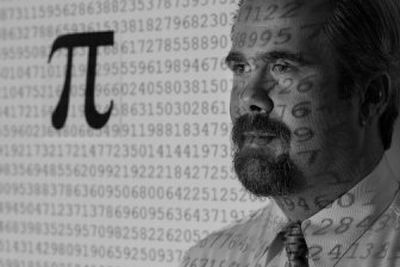For some, pi a natural high

This is a story about love. About inscrutable complexity and remarkable simplicity, about the promise of forever. It is about obsession and devotion, and grand gestures and 4,000-word love letters.
It is about a curious group of people with an almost religious zeal for a mind-numbing string of numbers. Actually one number, made up of a chain that is known – so far – to be more than a trillion digits long.
They are the acolytes of the church of pi.
And once a year many of them gather to talk about pi, rhapsodize about it, eat pi-themed foods (actual pie, sure, but so much more), have pi recitation contests and, just maybe, feel a little less sheepish about their unusual passion.
That day falls on Wednesday this year: March 14. Or 3.14. Obviously.
The question, of course, is why? And if you ask the fans of pi why, a startling number of them will come back with the same question: “Why climb Mount Everest?” Because it’s there.
But then they start talking about some very simple ideas. Like the beauty of a number that seems to go on forever and yet has no discernible pattern. Or about the valor of the memorization gymnastics, challenging oneself always to know more.
This is how Akira Haraguchi, a 60-year-old mental health counselor in Japan, puts it: “What I am aiming at is not just memorizing figures. I am thrilled by seeking a story in pi.”
He said this one day last fall after accurately reciting pi to 100,000 decimal places. It took him 16 hours. He does not hold the Guinness world record, only because he has not submitted the required documentation. But he has his story.
Incidentally, the world record belongs to Chao Lu, a Chinese chemistry student, who rattled off 67,890 digits over 24 hours in 2005. It took 26 videotapes to submit to Guinness.
Supercomputers have computed pi to more than a trillion decimal places, looking always for a pattern to unlock its mystery. And for centuries the number has fascinated mathematicians.
And then there are people like Marc Umile. Twelve years ago, while working as an usher at a Philadelphia opera house, he picked up a book on curiosities of math and read about pi’s seemingly infinite, random string.
He wondered about applying the way we absorb music to the mystical number. An obsession was born. In 2004, Umile read the digits of pi into a tape recorder. He did it a thousand at a time and gave it a rhythm – some numbers high-toned, some low.
He listened to the tape constantly. This went on for two years. A two-year trance.
“To and from work, in my quiet time, on my lunch break – and when I didn’t have the tape I would recite in the shower,” he says. “Probably 40 percent of the time there was an earphone in my ear. I said, ‘Oh my God, what have I created?’ “
What he created was what is believed to be U.S. record for pi memorization – 12,887 digits. He typed them into a spreadsheet at a Philadelphia law office – three-and-a-half hours, 1,000 numbers at a time, with two smoke breaks.
There are logical gathering places for people like this, and one of them is Massachusetts Institute of Technology, where, on March 14, students have been known to wish each other a happy Pi Day.
The school plays a role in encouraging this: In the past it has tried to mail its acceptance letters on March 14. It didn’t work out this year. And last year, when an MIT official wrote on an admissions blog that it probably wouldn’t work out then, either, he was greeted with disappointment. “Pi Day seems so romantic,” one prospective student wrote.
There’s a popular chant, an MIT rallying cry, that includes “3.14159.” (It rhymes with “Cosine, secant, tangent, sine!”
At the Exploratorium in San Francisco, there will be pies to eat, people wearing pi jewelry, more beads – color-coded by digit – added to the pi string. And celebrants will gather at a sort of pi shrine, a brass plaque engraved with pi’s first 100 digits.
It may be a stretch to say that pi has achieved a kind of cultural cachet, but it is true that, as an obsession, it’s not just for math geeks anymore. Givenchy makes a Pi perfume. Kate Bush sings out its digits in a song. And – of course – YouTube stocks videos of people reading pi into the camera.
Umile is already booked to appear on a local TV show Wednesday. The other night he rattled off 10,000 pi digits, just to keep the gears oiled.
Funny thing, though: For the life of him, he can’t remember the phone number he calls every month to make his mortgage payment. And the other day he got his own bank account number wrong.
“It starts with 6-1-4,” he says. “And I wrote 3-1-4.”